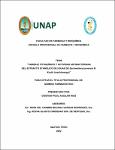Tamizaje fitoquímico y actividad antibacteriana del extracto etanólico de hojas de Eschweilera juruensis R. Knuth (machimango)
Abstract
One of the consequences of the misuse or abuse of antibiotics is that certain types of microorganisms become resistant to their effects. This makes it a public health problem. Therefore, the present research sought to identify the secondary metabolites and establish the antibacterial activity of the ethanolic extract of the leaves of Eschweilera juruensis R. Knuth (machimango) against Staphylococcus aureus ATCC 25923, Pseudomonas aeruginosa ATCC 27853 and Escherichia coli ATCC 25922 and their clinical isolates. Two methods were used: phytochemical screening, according to Schabra et al. and the Kirby-Bauer disk diffusion method, using concentrations of 125 mg/mL, 62.5 mg/mL and 31.25 mg/mL. Through phytochemical screening, the following secondary metabolites were identified: flavones, lactones, reducing sugars, alkaloids, triterpenes and steroids. Regarding the antibacterial activity, it was determined that the ethanolic extract of the leaves of this plant species was not active against any of the three bacteria tested, since diameters of inhibition halos equal to or less than 15 mm were obtained. Una de las consecuencias del mal uso o abuso de los antibióticos es que ciertos tipos de microorganismos se vuelven resistentes a sus efectos. Esto hace que sea un problema de salud pública. Por consiguiente, el presente trabajo de investigación buscó identificar los metabolitos secundarios y establecer la actividad antibacteriana del extracto etanólico de las hojas de Eschweilera juruensis R. Knuth (machimango) frente a Staphylococcus aureus ATCC 25923, Pseudomonas aeruginosa ATCC 27853 y Escherichia coli ATCC 25922 y a sus aislados clínicos. Fueron utilizados dos métodos: tamizaje fitoquímico, según Schabra y cols. y el método de disco difusión Kirby-Bauer, empleándose concentraciones de 125 mg/mL, 62,5 mg/mL y 31,25 mg/mL. Mediante el tamizaje fitoquímico fueron identificados los siguientes metabolitos secundarios: flavonas, lactonas, azúcares reductores, alcaloides, triterpenos y esteroides. Con relación a la actividad antibacteriana, se determinó que el extracto etanólico de las hojas de esta especie vegetal no fue activo frente a ninguna de las tres bacterias testadas, dado que se obtuvieron diámetros de halos de inhibición iguales o inferiores a 15 mm.
Collections
- Tesis [295]


